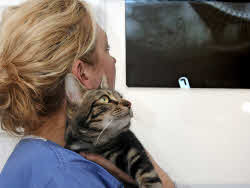We live in a litigious society and no one has a standard of care that can be easily defined
Abdominal radiology

Photo by VIN
Standard of care is one of those things that seems like it should be easy to define, but isn’t. There is no single, legal definition of standard of care. Some say it is the level of care the typical, similarly qualified, practitioner in a given location or community would provide. But who gets to decide what the typical practitioner looks like? Is the typical practitioner the average practitioner, in which case 50% of the practitioners are not adhering to standard of care? Or is the typical practitioner the person who graduated last in the class? And how big is the community in this day and age of telemedicine and internet? And why does this matter to the average client?
From the veterinarian’s point of view, unfortunately, one of the biggest reasons to worry about standard of care is from a defensive, cover-your-assets kind of thinking. The concern of lawsuits has made this happen and this is not a fun way to practice. But if a complaint to the state veterinary medical board is made or a lawsuit is brought, the standard of care is likely to be included in the discussion. The problem then is that hindsight bias can easily come into play. This is like Monday-morning quarterbacking, where once you know the poor outcome of one possible play, it is much easier to say that you would have chosen a different tactic if you’d been in charge. Only veterinarians have more at stake than a won or lost game; their livelihoods are on the line if their license to practice is revoked.
But again, this is hardly the only influencing factor. We all have a finite amount of time and veterinary medicine is an everchanging field. Sometimes a veterinarian simply hasn’t heard of the latest, greatest treatment options or hasn’t read the newest journal article about a new test for a specific disease. Is the typical practitioner one who works alone in a solo practice or one who works with many colleagues? Are they practicing on one species only or in one specialty area like ophthalmology or dermatology, or is the typical practitioner the jack-of-all-trades mixed animal veterinarian who provides all care to all animals? Is the typical practitioner a new grad or the veterinarian nearing retirement? The new grad may be more up-to-date on the latest developments, but those who have been around for decades have much more boots-on-the-ground experience, a lá Obi-Wan Kenobi in the first Star Wars (the fourth one in the series, the 1977 one, however you want to think of it). Which one prevails as typical?
And what constitutes the community? Does everyone in a county have the same standard of care regardless of zip code or income? What about shelter animals versus owned animals? Can they reasonably expect the same standard of care? If all veterinarians feel they must practice using all the bells and whistles, the gold standard if you will, as the standard of care, then what happens to the clients that can’t afford that? And does “can’t afford” equal “won’t pay for?" And who decides whether or not a given care plan is affordable for a given client? For instance, many private practice veterinarians recommend or require an intravenous catheter placement and/or preanesthetic bloodwork prior to all surgeries, including routine ones on young, healthy animals. Should that be the standard of care for all animals? What if a client can afford the spay surgery, but not if bloodwork is performed first? Is it acceptable to proceed without the initial testing? What if the client simply doesn’t want to pay for the blood tests? What if the pet is a shelter animal and not owned? Does any of that change the standard?
And does the community include my town, county, state or more? I can consult with colleagues all over the world. Are we all held to the same standard of care?
Of course, if a case ends up in front of a judge, jury, or veterinary medical board, none of them are particularly special beings capable of foretelling the future any better than the original veterinarian. So if a case goes south simply because that happens sometimes, why should any of these folks be allowed to determine if standard of care was met? And how do you prevent hindsight bias from occurring?
As I alluded, the reason this should matter to clients is because it affects them too. It is not infrequent that a veterinarian offers the best plan of diagnostics and care only to be told by the client that it is beyond their reach financially (or logistically, or emotionally, or or or…). If the veterinarian offers a plan B (or C, or D), when has the plan dipped below the threshold of standard of care? If the veterinarian has explained the pros and cons of plans A-D to the client, who gets to decide that threshold? And what happens if things go wrong with, say, plan C? Will the client remember that plans A and B were declined? Will the veterinarian be held responsible anyway?
More research is being done to find alternatives to the Cadillac (Tesla?) options of care. We need to have multiple levels to serve all pet owners and all pets. But in case you’re wondering why your veterinarian sighed and had a long pause before offering alternatives to your animal’s care the last time you asked, this may be why. We live in a litigious society and no one has a standard of care that can be easily defined and followed by all veterinarians. One bad experience with cutting a corner and being burned can cause any veterinarian to think twice the next time a client wants to do less than plan A. This outcome is a detriment for all.